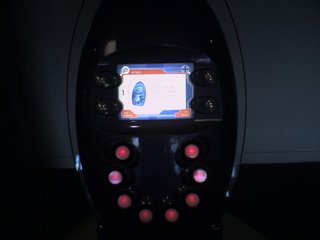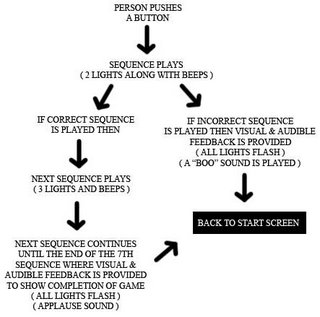BRIEF 1 - TECHNIQUEST
 On Wednesday 3rd October we visited Techniquest as a group to perform a study on the devices that were available. I took time interacting and observing with most of the exhibits until I found one that would be a good device to write a report on. The device I chose was called 'Simon', which seems to be based on a computer memory game of the same name. Now I had chosen my device, I played with it and observed other people, and here is a result of my findings:
On Wednesday 3rd October we visited Techniquest as a group to perform a study on the devices that were available. I took time interacting and observing with most of the exhibits until I found one that would be a good device to write a report on. The device I chose was called 'Simon', which seems to be based on a computer memory game of the same name. Now I had chosen my device, I played with it and observed other people, and here is a result of my findings:* The aim of the device is to test people's memory whilst getting them to learn about sequence and sound. It is entertaining, having visual and audible feedback, but it seems to have no longevity to it. It has one function, which I expect will make people bored after a little while.
* The target audience seems to be directed at the younger audience as there are no complicated procedures that would make it entertaining for adults. It seems more of a challenge for children as their memories may not be as well developed as adults'. There are instructions that are split between two screens that alternate every couple of seconds. Younger children may not be patient enough to wait for this. The device would be equally as interesting for male/female. The device is not very easy for people with visual or hearing difficulties. People who are visually impaired may not be able to read the small text instructions on-screen. Also, people who have impaired hearing might not be able to hear the added sounds with the game. There are no additional options to change the size of the text or the volume of the music. The design does incorporate flashing lights and sounds into the design which are suitable for the target audience (children). The process is controlled by the device and then the user has to interact and copy the order that the device has given.
LAYOUT
 The device has a monitor screen along with 4 buttons controlling each option next to the screen. There is one that has no function. There is one that alternates between the English/Welsh language. Then there are two that explain the science and music behind the exhibit. The 'Why Science' button explains the science of how we interpret sounds, and the two different types of memory we have - short & long term memory. It explains how our memories need repetition of familiar sequences for it to stick in our minds and for us to remember it on a long-term basis. The 'Why Music' button explains the theory behind the music and why some tunes are memorable, sad/jolly etc. It automatically displays the instruction screen, which alternates between two pages when there is inactivity for 10 seconds. This is a handy feature as the instructions are always displayed when a new person starts interacting with the exhibit.
The device has a monitor screen along with 4 buttons controlling each option next to the screen. There is one that has no function. There is one that alternates between the English/Welsh language. Then there are two that explain the science and music behind the exhibit. The 'Why Science' button explains the science of how we interpret sounds, and the two different types of memory we have - short & long term memory. It explains how our memories need repetition of familiar sequences for it to stick in our minds and for us to remember it on a long-term basis. The 'Why Music' button explains the theory behind the music and why some tunes are memorable, sad/jolly etc. It automatically displays the instruction screen, which alternates between two pages when there is inactivity for 10 seconds. This is a handy feature as the instructions are always displayed when a new person starts interacting with the exhibit.FLOW DIAGRAM
I have created a diagram below to show the flow of information when someone interacts with the device.

OBSERVING A PARTICIPANT ON THE EXHIBIT
 Not many people seemed to bother with the exhibit that I had chosen to research. It was out of view as it was on the first floor of Techniquest hidden behind some other exhibits. Many of the visitors (most of whom were children) walked straight past not giving the exhibit much attention. After waiting patiently for a while for someone to play the game properly, a child about 8-10 stopped by the device. After briefly reading the instructions on the screen he pushed one of the buttons. He seemed to get the gist of the game but only played up until the 4th or 5th sequence where he incorrectly copied the sequence, at which point, after realising he had lost, he moved onto another device. It was about 20 minutes later before someone else played the game. This time it was a girl who was a little older. She seemed more interested and took time to look at the instructions and look at the 'why science' and 'why music' sections. She started playing and seemed to really concentrate on not making a mistake. She won the game, and then won another without making a mistake.
Not many people seemed to bother with the exhibit that I had chosen to research. It was out of view as it was on the first floor of Techniquest hidden behind some other exhibits. Many of the visitors (most of whom were children) walked straight past not giving the exhibit much attention. After waiting patiently for a while for someone to play the game properly, a child about 8-10 stopped by the device. After briefly reading the instructions on the screen he pushed one of the buttons. He seemed to get the gist of the game but only played up until the 4th or 5th sequence where he incorrectly copied the sequence, at which point, after realising he had lost, he moved onto another device. It was about 20 minutes later before someone else played the game. This time it was a girl who was a little older. She seemed more interested and took time to look at the instructions and look at the 'why science' and 'why music' sections. She started playing and seemed to really concentrate on not making a mistake. She won the game, and then won another without making a mistake.ANY REPETITION IN SEQUENCE?
From studying and playing the repeatidly I have found there to be no random function in the game. The instructions ask you to press any button at the start. The computer then picks a predetermined sequence from the button that you press initially. The diagram below shows what sequence there will be from what button you press first:
BUTTON 1: 1 -> 3 -> 4 -> 6 -> 4 -> 7 -> 8
BUTTON 2: 2 -> 3 -> 4 -> 8 -> 7 -> 6 -> 3
BUTTON 3: 3 -> 4 -> 6 -> 7 -> 8 -> 1 -> 2
BUTTON 4: 4 -> 1 -> 2 -> 3 -> 4 -> 7 -> 8
BUTTON 5: 5 -> 4 -> 7 -> 3 -> 6 -> 1 -> 2
BUTTON 6: 6 -> 4 -> 1 -> 2 -> 3 -> 7 -> 6
BUTTON 7: 7 -> 3 -> 5 -> 7 -> 8 -> 1 -> 3
BUTTON 8: 8 -> 4 -> 3 -> 4 -> 7 -> 2 -> 1
From the realisation that there is no random function in the game and each of the buttons has the same number of buttons in the sequence, I have come to the conclusion that this game has no longevity to it. Once a player has played the game a few times and has realised that the sequences are the same all the time, and there is no difficulty setting or extra features they will become bored of it and walk away.

0 Comments:
Post a Comment
<< Home